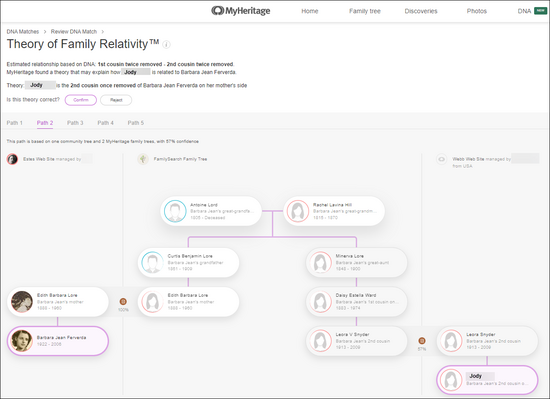
The Theory of Family Relativity™ is an advanced DNA feature from MyHeritage that provides theories on how a person is related to a given DNA Match. Introduced in February 2019,[1] Theory of Family Relativity™[2] combines the power of autosomal DNA testing with tree matching and supporting documents from MyHeritage’s extensive record collection.
Theory of Family Relativity (TOFR) automatically constructs “theories” which are paths to your matches and shows you which ancestor or ancestors you have in common.
How Do I receive Theories of Family Relativity?
Theories are calculated automatically for all customers who have taken a MyHeritage DNA test or uploaded their DNA data to MyHeritage. Having a larger and more detailed family tree on MyHeritage can increase your chances of receiving more Theories.[3]
How are Theories of Family Relativity discovered?
MyHeritage developed innovative, cutting-edge technology that utilizes a big data graph that connects millions of data points and computes all possible paths between two DNA matches to determine when any two points are likely to be the same person. Theories then calculates the strengths of the various paths, generating the Theory confidence score.
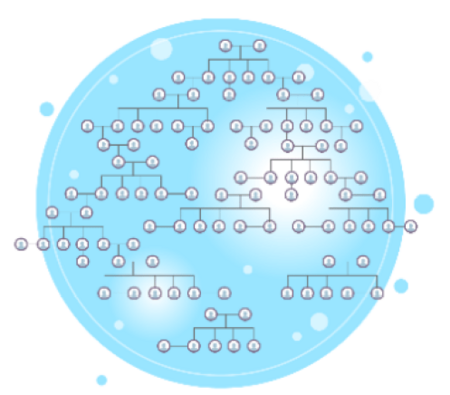
When a connecting path is discovered, a theory is constructed. Sometimes multiple paths can be discerned utilizing different trees or documents. Occasionally people are connected via multiple paths because they share multiple ancestors or ancestral couples. Theories of Family Relativity can reach back up to six ancestral generations.
How do Theories work?
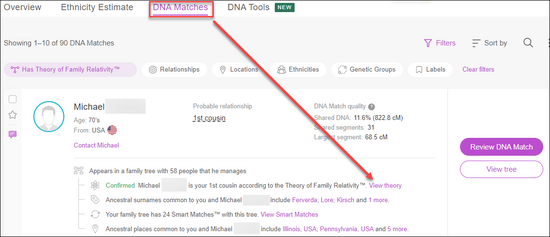
Click on DNA matches, then look or filter for matches that display “View Theory.” You can either click on “View Theory,” or on the purple “Review DNA Match” button.

Matches can easily be filtered to select matches with Theories of Family Relativity.
Providing possible relationship paths saves genealogists innumerable hours of sifting through their matches’ trees, trying to identify common ancestors.
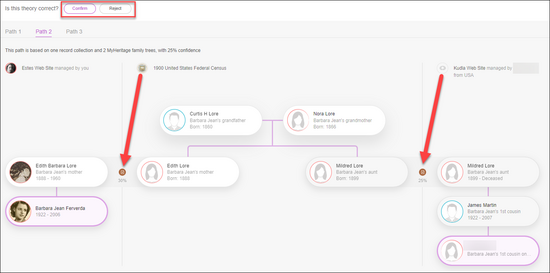
Multiple paths may be created utilizing join points such as:
- Personal family trees maintained by MyHeritage users
- Community trees such as FamilySearch, WikiTree, Geni and Filae
- MyHeritage record collections, such as the census.
How can I be confident theories are accurate?
Each joining link is provided with a confidence level that the people being connected are the same individual.

Clicking on the link displays the record for this individual for evaluation. Is Edith Barbara Lore 1888-1960 in one tree the same person as Edith Lore born 1888 in the 1900 census?
Click on the confidence button to see the corresponding details.
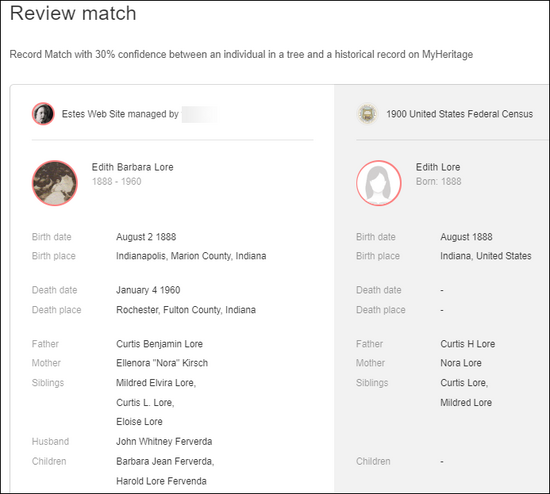
In this case the connection was made by comparing an individual in a user’s website with the 1900 census. This link is correct, as is the second connecting link for this Theory of Family Relativity, making the entire Theory accurate.
Can I confirm or reject a Theory?
New theories will have a pending status by default. If a Theory of Family Relativity is accurate using any path, confirm the theory. If the Theory is inaccurate, reject the theory. This can help the user keep track of the theories they have already reviewed and evaluated.

Note that confirming correct theories is not enough on its own. We encourage you to update your family tree to include new information conveyed in any theory you believe is correct (e.g., by adding individuals currently missing in your tree who are included in the theory).
Almost everyone has at least a few Theories of Family Relativity, but if you don’t, you can always test close relatives – in fact – you should. Close relatives may have Theories of Family Relativity that are every bit as relevant to your genealogy as your own matches. Parents are particularly useful, as are grandparents, aunts, uncles, siblings and cousins. If either of your parents is unavailable to test, your siblings carry some of your parent’s DNA that you do not, so be sure to test them.
How do I receive new Theories?
New trees and information in the MyHeritage data collections are being added daily, so MyHeritage updates their Theories of Family Relativity periodically[4]. Be sure to follow the MyHeritage Blog and social media accounts to keep up with when new Theories are available.[5]
In the meantime, evaluate and work with your existing theories.[6][7]
What can I do to help Theories form?
You can encourage theories to form by enhancing and providing more detail in your tree by adding details, evaluating and confirming or rejecting both Smart Matches™[8] and Record Matches.[9][10]
Often, theories are formed[11] by being able to connect the descendants of the children of one ancestor with the children of that ancestor’s sibling. To provide MyHeritage with more fodder, extend your tree at least two generations, if not more, from each known ancestor. Listing each ancestor’s grandchildren, and hopefully their spouses, provides MyHeritage with more join possibilities in each tree.
Explore more about Theory of Family Relativity
- Using the Theory of Family Relativity™ to Research Your DNA Matches, a webinar by Ran Snir on the MyHeritage Knowledge Base
- Ask The Expert – Theory of Family Relativity™: Nailed It or Not?, a webinar by Daniel Horowitz on the MyHeritage Knowledge Base
- Facebook Live: An Inside Look at the Theory of Family Relativity™ with Uri Gonen, a webinar by Uri Gonen on the MyHeritage Knowledge Base
- Suggested Relationship Paths: An Inside Look at the Theory of Family Relativity™ at Legacy Family Tree Webinars
- Using the Theory of Family Relativity to Research Your DNA Matches at Legacy Family Tree Webinars
- Why I Like MyHeritage’s Theory of Family Relativity for DNA Matches at Your DNA Guide
- Tips & Tricks for Working with Theories of Family Relativity at DNAeXplained – Genetic Genealogy
- How Can YOU Get Theories of Family Relativity at MyHeritage? at DNAeXplained – Genetic Genealogy
References
- ↑ Introducing The Theory of Family Relativity™ — a Genealogy Game-Changer. DNAeXplained – Genetic Genealogy
- ↑ MyHeritage’s New Theory of Family Relativity. DNAeXplained – Genetic Genealogy
- ↑ Theory of Family Relativity is a premium feature that requires either an active Premium, PremiumPlus, or Complete site subscription. Those without a subscription can see all of their theories, but in order to view all of the details, a subscription is required. Those who have uploaded their DNA from another testing service can pay the one time $29 unlock fee to access all of the advanced DNA features and tools, including Theory of Family Relativity or subscribe.
- ↑ Why You Should Check Your Theories of Family Relativity™ Regularly. MyHeritage
- ↑ MyHeritage Updates Theories of Family Relativity – Who is Waiting for You? DNAeXplained – Genetic Genealogy
- ↑ MyHeritage Updates Theories of Family Relativity. DNAeXplained – Genetic Genealogy
- ↑ MyHeritage: Brand New Theories of Family Relativity. DNAeXplained – Genetic Genealogy
- ↑ What Smart Matches™ Are and How to Make the Most of Them. MyHeritage
- ↑ Introduction to Record Matches. MyHeritage
- ↑ How Can YOU Get Theories of Family Relativity at MyHeritage?. DNAeXplained – Genetic Genealogy
- ↑ Tips & Tricks for Working with Theories of Family Relativity. DNAeXplained – Genetic Genealogy